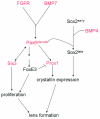Signaling during lens regeneration
- PMID: 17157042
- PMCID: PMC1828075
- DOI: 10.1016/j.semcdb.2006.10.001
Signaling during lens regeneration
Abstract
The newt is one of the few organisms that is able to undergo lens regeneration as an adult. This review will examine the signaling pathways that are involved in this amazing phenomenon. In addition to outlining the current research involved in elucidating the key signaling molecules in lens regeneration, we will also highlight some of the similarities and differences between lens regeneration and development.
Figures


Similar articles
-
Lens regeneration from the cornea requires suppression of Wnt/β-catenin signaling.Exp Eye Res. 2016 Apr;145:206-215. doi: 10.1016/j.exer.2016.01.003. Epub 2016 Jan 8. Exp Eye Res. 2016. PMID: 26778749 Free PMC article.
-
Cell signaling pathways in vertebrate lens regeneration.Curr Top Microbiol Immunol. 2013;367:75-98. doi: 10.1007/82_2012_289. Curr Top Microbiol Immunol. 2013. PMID: 23224710 Free PMC article. Review.
-
A critical role for thrombin in vertebrate lens regeneration.Philos Trans R Soc Lond B Biol Sci. 2004 May 29;359(1445):765-76. doi: 10.1098/rstb.2004.1467. Philos Trans R Soc Lond B Biol Sci. 2004. PMID: 15293804 Free PMC article. Review.
-
Eye on regeneration.Anat Rec B New Anat. 2005 Nov;287(1):42-8. doi: 10.1002/ar.b.20084. Anat Rec B New Anat. 2005. PMID: 16308862 Free PMC article. Review.
-
Unique expression patterns of the retinoblastoma (Rb) gene in intact and lens regeneration-undergoing newt eyes.Anat Rec A Discov Mol Cell Evol Biol. 2003 Mar;271(1):185-8. doi: 10.1002/ar.a.10023. Anat Rec A Discov Mol Cell Evol Biol. 2003. PMID: 12552633
Cited by
-
Molecular and cellular aspects of amphibian lens regeneration.Prog Retin Eye Res. 2010 Nov;29(6):543-55. doi: 10.1016/j.preteyeres.2010.07.002. Epub 2010 Jul 16. Prog Retin Eye Res. 2010. PMID: 20638484 Free PMC article.
-
Dedifferentiated follicular granulosa cells derived from pig ovary can transdifferentiate into osteoblasts.Biochem J. 2012 Oct 15;447(2):239-48. doi: 10.1042/BJ20120172. Biochem J. 2012. PMID: 22839299 Free PMC article.
-
Lens regeneration from the cornea requires suppression of Wnt/β-catenin signaling.Exp Eye Res. 2016 Apr;145:206-215. doi: 10.1016/j.exer.2016.01.003. Epub 2016 Jan 8. Exp Eye Res. 2016. PMID: 26778749 Free PMC article.
-
A focus on the optical properties of the regenerated newt lens.PLoS One. 2013 Aug 22;8(8):e70845. doi: 10.1371/journal.pone.0070845. eCollection 2013. PLoS One. 2013. PMID: 23990914 Free PMC article.
-
Insights into Bone Morphogenetic Protein-(BMP-) Signaling in Ocular Lens Biology and Pathology.Cells. 2021 Sep 30;10(10):2604. doi: 10.3390/cells10102604. Cells. 2021. PMID: 34685584 Free PMC article. Review.
References
-
- Eguchi G. Electron microscopic studies on lens regeneration: I, mechanisms of depigmentatioon of the iris. Embryologia. 1963;8:45–62.
-
- Tsonis PA. Regeneration in vertebrates. Dev Biol. 2000;221:273–284. - PubMed
-
- Eguchi G. Electron microscopic studies on lens regeneration: II, formation and growth of lens vesicle and differentiation of lens fibers. Embryologia. 1964;8:247–287.
-
- Yamada T. Control mechanisms in cell-type conversion in newt lens regeneration. Krager; Basel: 1977. - PubMed
-
- Walsh PN, Schmaier AH. Platelet-coagulant protein interactions. In: Colman RW, Hirsh J, Marder VJ, Salzman EW, editors. Hemostasis and Thrombosis: Basic Principles and Clinical Practice. 3rd ed. J.B. Lippincott Co.; Philadelphia: 1994. pp. 629–651.
Publication types
MeSH terms
Grants and funding
LinkOut - more resources
Full Text Sources

